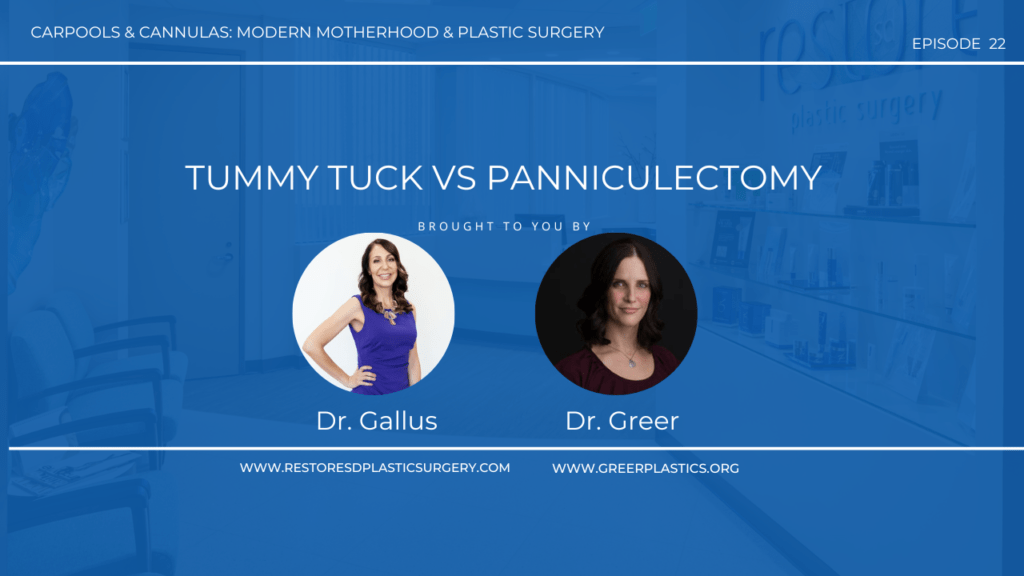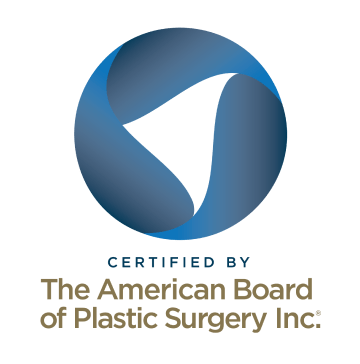In this episode of Carpools & Cannulas, Dr. Greer of Greer Plastic Surgery in Cleveland, OH, and Dr. Gallus of Restore SD Plastic Surgery in San Diego, CA discuss the difference between panniculectomy and abdominoplasty. They go over why one is generally covered by insurance and the other is a cosmetic procedure. They also share tips on recovery and when liposuction is a good idea to enhance results.
Transcript
Dr. Greer: All right, let’s try this again. This is Dr. Greer from Greer Plastic Surgery in Cleveland, Ohio. And we’re gonna be joined tonight by Dr. Gallus from Restore SD Plastic Surgery in San Diego, California. We are having internet troubles though. So hopefully, she’ll be able to pop on in a second. And we’re gonna be talking about panniculectomy versus tummy tuck, which is an awesome topic because it’s kind of confusing that they’re different. Let’s see if this pulls her on.
Dr. Gallus: Okay.
Dr. Greer: Are you back? Okay. I don’t know. You froze and then it couldn’t accept you again. So I closed down, and we’re up here.
Dr. Gallus: Yeah, sorry. We did upgrade. I feel like someone commented on one of our previous things about switching to AT&T, the fiber, whatever internet, and my husband did that, but I cannot perceptively notice the difference. So…
Dr. Greer: I think it’s to the point where, like, if you have three TVs streaming and then you get on, you can maybe tell a difference, but otherwise it’s all the same.
Dr. Gallus: Yeah. Right. Yeah. So yeah, let’s talk. This is actually so topical because my middle daughter had soccer tournament this weekend and at one of the games I was sitting there with the moms and we had a whole conversation about panniculectomy, abdominoplasty insurance. It was all mixed in there. Even some, like, it’s cheaper to go to Mexico and do it. And I was, like, “Sure. Yeah, you do that.”
Dr. Greer: Yeah, don’t do that. People do that, they have complications, they come back, they’re unhappy. But yeah, people always wanna know if they can get their tummy tuck covered by insurance. And I mean, really not that often, honestly, it’s not often. And when insurance does cover, it’s only panniculectomy, which is why that’s an important topic on what the difference is.
Dr. Gallus: It’s right. Panniculectomy is… I know you get what you pay for. Is a pannus removal. Right?
Dr. Greer: Pannus means apron, by the way, it’s the little apron of skin, the skin apron. And it’s literally just taking off the overhang. Tummy tuck adds a lot more to it.
Dr. Gallus: Right. So that overhang, a lot of times, even if you just had a little bit of overhang of tissue and that’s with you standing because we can all, like, kind of bend over and get a little bit of extra.
Dr. Greer: Yeah. Just don’t do that. You’re not supposed to do that. You’re supposed to stand straight up.
Dr. Gallus: Anyway, so that overhang, I know out here, the insurance requirement is that it has to cover your pubic area, that much out.
Dr. Greer: In Ohio. Right. That’s like this much overhang, people. That’s pretty significant. Like, I operated on a patient this morning who had lost over 100 pounds and she did not have that much skin. It was… I mean she had lots of skin, but not that dramatic of an overhang.
Dr. Gallus: How tall was she? Just out of curiosity.
Dr. Greer: She was about my height, like 5′ 5, 5′ 6.
Dr. Gallus: Oh, okay.
Dr. Greer: Okay. I’m not that tall. I’m 5’4, but somewhere around there. Like, not super tall, but most of her excess skin was in the horizontal dimension.
Dr. Gallus: Oh.
Dr. Greer: Like I took off her entire abdominal wall and did a vertical closure, but insurance only wants to cover what’s medically necessary. And when you get that overhang that’s covering the entire pubic area, a lot of people get skin irritation and chronic yeast infections. And that’s why insurance will cover that removal. But a full tummy tuck also involves elevating the skin all the way up to the costal margin, which is where your ribs are. So we lift the skin up all the way above the belly button and the belly button gets transposed to a new spot, that’s not included in the panniculectomy and the abdominal muscles aren’t tightened in a panniculectomy. So it’s an entirely different operation.
Dr. Gallus: Right. I might… Somebody else just came out of my… I might have lots of interruptions. She’s like, “What?” Anyway, yes, totally different operation. It’s really hard to kind of explain what that difference is. And yeah, I once did panniculectomy in training. We did a lot actually, because people were a little bit bigger in Indianapolis, at least than in Southern California, and there were patients that it was, like, down to their knees. Like, their pannus went down to their knees. I know. So it was really an impairment. And then when you took off that much tissue, I mean, it enabled them to walk again, because they had this huge amount of tissue hanging down across their abdomen.
That being said, it is, like, opposite of a cosmetic result. It just, they’re still wide, it’s not done with any liposuction, you leave the belly button alone generally. And so yeah, I mean it’s a functional, it’s considered a functional operation. We’ll say I just did one a couple weeks ago. I only ask about how tall your patient was because my patient was five feet maybe if she stretched a little, and she had lost 140 pounds. And so she had that pannus that hung over and definitely met insurance criteria. So that’s the direction we went in, but I was able to get more tissue off of her as long as she was willing to accept me removing her belly button.
Because as you know, you know, if you just take the lower tissue and you can’t pull down too hard, otherwise you pull the belly button down to, like, way, way, way low. And it looks weird. And the limitation of how much you can remove and close is limited by that. And so I said, you know, I can take a little bit more off if you don’t want your belly button. So, and that’s the second time I’ve done that where they’re, like, “It’s fine with me.” And so no belly button, got 14 pounds of tissue off, which is substantial.
Dr. Greer: It’s a lot. It’s significant. Yeah. Yeah.
Dr. Gallus: Not the most I’ve ever taken off anybody. Again, Indiana provided me with the opportunity to take… I feel like we got close to 50 pounds off of somebody once. Yeah.
Dr. Greer: Did they have lymphedema though? I feel like they must have had lymphedema.
Dr. Gallus: No, they were just… Some of these patients were really huge and they weren’t even weight loss patients. They had like a medical reason that somebody needed to get into their abdomen, like, a hysterectomy or a general surgery procedure. And we were there basically to find the abdomen for the patient. So we’re talking, like, 600-pound patient.
Dr. Greer: Gotcha.
Dr. Gallus: Yeah.
Dr. Greer: Yeah. I mean because when it’s, like, skin folds people, like, you can just… I mean, you can end up, like, dissecting down and down and down and just end up, like, on the OR table.
Dr. Right. You don’t want…
Dr. Greer: And miss the abdomen entirely because it’s still a tiny little person inside there.
Dr. Gallus: That’s right. It’s the big yellow overcoat. That’s what we used to call it.
Dr. Greer. Yeah.
Dr. Gallus: So yeah, so that was our deal. I don’t miss those cases because again, when you have that much tissue that you’re removing, you have some blood loss because there’s blood in that tissue. Right? You have fluid shifts, and the wound healling, it’s a long, long, long incision, and so you generally are gonna have some sort of wound healing complication or fluid collection or.
Dr. Greer: And it’s thick too because there’s a lot of adipose or fat tissue, which isn’t really well vascularized. So you end up with really slow healing wounds, and there’s some big vessels in those skin flaps too.
Dr. Gallus: Yeah, absolutely. Yes. We used to use… This will matter to nobody except for us it’ll be interesting. But we used to tie off those vessels when we were doing that because there’s so many. So we would just clamp, clamp, clamp, clamp, clamp, and then stop and tie off the vessels with Vicryl. And we used to have a 3-O Vicryl spool that looked…
Dr. Greer: Yeah.
Dr. Gallus: Have you ever seen that?
Dr. Greer: Oh, we used to use them for… My chairman loved free nipple breast reductions and he made us tie everything with a 3-O Vicryl spool. It was fun.
Dr. Gallus: It is fun actually. I mentioned it when I was operating on this other panniculectomy and they had no idea what I was talking about. I’m like, it looks like a…
Dr. Greer: Like a little reel of tissue or of a suture. It’s cool.
Dr. Gallus: Yeah. It looks like something you’d put on a sewing machine and you just… You don’t need more sutures. You just keep spooling it out.
Dr. Greer: It’s nice for the scrub techs. Yeah. But I mean, it just, it takes forever to do that and to, like, get into all those vessels. What’s really interesting. I was trying to explain to my assistant today, because I did a weight loss removal for a weight loss skin removal patient. So she’s super thin. She has, like, literally this much body fat, but all those blood vessels are still there. They’re just smaller. So my poor assistant is, like, “Why are there so many blood vessels in this person?” Well, it’s because she had enough to support that really thick skin flap. And now that she’s really thin the vessels are all there. They’re just smaller.
Dr. Gallus: Yeah. They’re just still there. Absolutely. Yeah, so it is a really…It is like I said, a life-changing operation for patients to get rid of that, and sometimes it… I was just reviewing abstracts for plastic for the ASPS for our National Society Resident Abstracts, and right before the deadline. I was, like, “What are these two? Oh, I have 80 abstracts to review. Awesome.” Oh hi.
Dr. Greer: Hi, Melody. Good to see you girl.
Dr. Gallus: They were, like, “Which Dr. G?”
Dr. Greer: Oh yeah, because that’s Gallus. I’m Greer. But I know she’s mine. I know Melody.
Dr. Gallus: Cool. So yeah. Anyway, one of ’em was about how weight loss patients that undergo body contouring procedures tend to then lose more weight than somebody who doesn’t undergo the body contouring procedure. Because it does, it gives them, like, a little extra boost. You just lost another 14 pounds maybe that was in your way, and now you can exercise easier. You’re not chafing or you’re not dealing with infections or whatever it is. So it wasn’t the best designed study, but it definitely raised a good question and one that could be answered I think, and certainly, you know, be worth looking into. I don’t know.
Dr. Greer: For sure. Well, and I wonder too, how much is, like, you stop losing weight because you lose motivation… Oh, Melody, blessed to have you too. She’s a sweetheart. Love her. But you know, like, when you have so much skin, you can’t even tell what your body looks like under there. And I think sometimes just tailoring that skin to the new body is motivating because you can see what you look like.
Dr. Gallus: Right.
Dr. Greer: Oh. How far do you wait after weight loss surgery? Really the biggest thing is the weight needs to be stable.
Dr. Gallus: Right. So I would say the soonest most people are able to have surgery is I would say 18 months after weight loss surgery because it gives you a year to lose weight and then six months to remain at that stable weight. That’s, like, a ballpark time. So, and I know in particular, this last patient, she had lost the 140 pounds long before a year. And she had been at that stable weight for six months. So she was, like, maybe at 15 or 16 months. And actually, insurance was, like, “Nope, she has to be at 18 months. Resubmit.” And we’re shy like a month. So we waited and then we…
Dr. Greer: Of course.
Dr. Gallus: Yeah, so…
Dr. Greer: Because the longer they hold onto their money, the longer it’s invested and makes lots of money. Yeah. That’s the whole insurance game. But if you’re not going through insurance, really, if your weight’s been stable six months… because I’ve seen a couple patients really just drop down to their goal, weight, and stay there very quickly. You just wanna make sure your weight’s stable. You’re not gaining or losing.
Dr. Gallus: Yeah. So six months of stable weight is… It just depends. There’s so many things that depends on how much weight do you lose. Yeah. So for insurance only, I would say that 18 months, that’s where they’re getting it from is that it’s on average 12 months to achieve your weight loss and then another six months to stay there. But as Dr. Greer was saying, like, if you drop all the weight in four months and then you’re there at that weight for six months, you could have the surgery as early as 10 months…
Dr. Greer: Right. If insurance won’t cover it. They don’t want to.
Dr. Gallus: Right. They throw as many roadblocks up as possible.
Dr. Greer: They wanna make it absolutely as hard as possible. And so, a lot of times when people want skin removal after weight loss, they really want that abdominoplasty result, but insurance pays for panniculectomy. So do you ever, like, bill through insurance partially and then do abdominoplasty for cash pay? I used to kind of do that. Now I’m just out of insurance entirely.
Dr. Gallus: Yeah. sometimes I do that, but now I feel, like, it would have to be the perfect patient because it’s hard to separate the two codes. And even in this most recent patient, she was considering doing liposuction. I’m like, we’re not gonna get the best cosmetic result with the panniculectomy. So let’s get that weight off and then see where you are. See if you’re gonna lose more weight, see how things change. And then you can really focus on… because sometimes I think it’s just less of a result. It just depends on how large they are to start with and all of those things, how much extra skin they have. And people lose weight, like, so differently. Right? I mean just like people gain weight in different places.
Dr. Greer: They do. It’s amazing because, like, I’ll see a patient with a BMI of 28. Who’s actually a terrible tummy tuck candidate because all of their fat is, like, that visceral hard intrabdominal fat and they have these skinny arms and legs. And then I’ll see somebody who’s got a BMI of like 38, but they have this tiny little waist and tummy because they just gain weight very evenly over their whole body. So it’s, you know, this is why I don’t have a strict BMI cut-off. It’s very patient-dependent.
Dr. Gallus: Yeah. It definitely, it depends. Height, where you lost the weight, how much is extra skin? There’s so many factors. So yeah, I agree. I think they get confused a lot. People do, like, try to say, “Well, insurance will cover it if I don’t feel good about myself.” No.
Dr. Greer: Well, and the other question we get asked all the time too, is will they cover the diastasis repair? So your two six-pack muscles, the fascia between them stretches apart to accommodate extra weight, baby, whatever. And the fascia doesn’t go back all the way. So you have that widening, which is what diastasis means. And it does cause functional problems. It can cause low back pain. It can contribute to pelvic floor issues like urinary stress incontinence. Insurance almost never covers repair of that. I had it covered once and, like, it was a huge fight.
Dr. Galllus: Yeah. I’ve never seen it covered. And the other thing is when we’re talking about this stuff, it’s so regional too. Like insurance varies from state to state, from plan to plan, and all these other things. So yeah, I’ve never seen it get covered. And the components of a tummy tuck are that removal of excess skin and fat, the diastasis repair, and transposition of the belly button. So you get…
Dr. Greer: Yep. It stays where it is and it comes out through a new hole in the skin. That’s what we’re transposing. Now, I almost always do liposuction at the same time, technically a separate procedure, but very few patients don’t need liposuction of the waist or hips just because you wanna address their torso, 360 degrees around or you end up giving them this flat tummy and they’re kind of like SpongeBob Squarepants, like, squared off. It’s not a good look.
Dr. Gallus: Correct. Yeah. So it’s like a… Yeah, it’s a different procedure to do an abdominoplasty, totally all the things.
Dr. Greer: Now, I did see a question pop up, what procedures can you combine with abdominoplasty? You can combine a lot of things. Although, we generally like to keep it all in, like, the same global area. So I’ve done abdominoplasty with thigh lift. I do it often with breast, either lift, augmentation, implants, whatever. I’ve done it with brachioplasty too.
Dr. Gallus: Yes, I would not do… You can walk through. That’s fine. So yeah, you can combine it with lots of procedures. I would say the most common procedures combined with, although some of us don’t technically consider it an extra procedure is liposuction. Right? It almost always… I feel like more patients have liposuction with their abdominoplasty than not which wasn’t always the case. People thought that was very controversial to do the two together.
Dr. Greer: Oh, and when I was in residency, like, you did not liposuction the abdominal skin at all, it was only the waist and the hips. And now we know as long as you’re sticking to the deeper fat, the subscarpal layer, it’s actually good for blood supply to the flap because you’re removing fat that just kind of steals nutrients and blood flow.
Dr. Gallus: Right. Right.
Dr. Greer: Things change, we learn. And it’s good because I feel, like, the end result is so much better.
Dr. Gallus: Right. Absolutely. Yeah. So I’d say that’s the most common combo.
Dr. Greer: I remember I did do tummy tuck and eye lift once randomly.
Dr. Gallus: I would not do tummy tuck and facelift. I’ve actually had somebody ask me that. It’s just a lot debris.
Dr. Greer: And it’s a lot, like, I get tired doing those. I don’t wanna do that combo.
Dr. Gallus: Yeah. I don’t wanna do facelift with anything else other than face, to be honest.
Dr. Greer: Yeah.
Dr. Gallus: Yeah. So I’ve done… Tummy tuck and arms would be tough. It’d have to be the right patient just because you’re already kind of stooped over and then you kind of…and then your arms hurt, but it’s doable. It’s more common with thighs because they work together that operate. And this one’s a little controversial, but I will do a tummy check with a BBL. I know some people won’t do…
Dr. Greer: Will you? I’ve been asked that, and I’m, like, well, I don’t like BBLs, you know. I don’t love BBLs thankfully there’s not a real high demand here in the Midwest, but I feel like you gotta lay on your side for the BBL or your stomach. And then…
Dr. Gallus: I think I have to play on their side sort of, like, in a little fetal position or you could get you know, a pool floaty and kind of, like, chill on that so that it raises you up a little bit. It requires mechanics, but yeah, because with the BBL, so the Brazilian butt lift or fat transfer to the buttocks, you don’t wanna sit on your bottom and put pressure on that fat that we’ve just transferred. And with the abdominoplasty you’re bent over, your knees are up kind of in a reclined beach chair position, which would put everything on your booty. But yeah, you just have to be prepared to lay…
Dr. Greer: Lay in the fetal position for a week.
Dr. Gallus: Yes, yes.
Dr. Greer: Oh, we have a question from a premed asking why we chose plastic surgery.
Dr. Gallus: Hmm. You go first.
Dr. Greer: Okay. So I actually very distinctly remember this. I did my surgery rotation at MetroHealth, which is the trauma hospital here in Cleveland. And I still remember my very first case that I scrubbed in on general surgery with Dr. Prebi. He’s this like short little, like, guy. And it was a lysis of adhesions, which you’re just, like, cutting scar tissue and bowels. It’s literally the most boring thing ever. And I was totally fascinated, and I love surgery, but the general surgeons were all very unhappy and worked a bajillion hours, and the plastic surgeons, they loved life. They still love life. And there’s just so much more creativity. I don’t know. It’s just, we’re like happy people and we get to be surgeons, but not actually kill ourselves working 80 hours a week every week.
Dr. Gallus: Yeah. I mean, I did general surgery first as I did a traditional general surgery and then plastic surgery to follow. But I just thought the operations were cooler.
Dr. Greer: Yeah, they are way cooler. I mean, I would do breast augmentations all day long over… I’m sure gallbladders are fine, but.
Dr. Gallus: I didn’t really like laparoscopic surgery that much anyway. So yeah. It’s just about finding your surgery niche. I remember being a med student and peering in at one of the other rooms when I was a general surgery on a general surgery rotation, I was like, “What are they doing?” And they were doing a TRAM operation. So taking, you know, muscle from the abdomen to recreate the breast. And I was like, “What?”
Dr. Greer: That was crazy. I mean, plastic surgeons do face transplants and hand transplants. Like not me, but other ones do, or you can do cleft palate or cleft lip. You can do, like, craniosynostosis surgeries. Like it’s just plastic surgeons are, like, the surgeons who still do a little bit of every field of surgery because you could do microsurgery, you could do fractures. I mean you can do everything in plastics.
Dr. Gallus: Yeah. Um, I just asking about a 360 abdominoplasty. Right.
Dr. Greer: I’m gonna guess that’s just with the liposuction or are you talking about lower body lift?
Dr. Gallus: So I think that’s… So I think in the past if you asked me 10 years ago, I would’ve thought it meant a lower body lift. So removing or a belt lipectomy where the excision goes all way around. But I think in today’s world that’s considered what I call 360 liposuction with the tummy tuck. And I feel like it gives you the best result because again, you’re not looking at the patient only from the front, they don’t get squared off. They get that nice curve. And then when they turn around, it’s still same curve kinda scoop out the lower back. It does give you a nice profile of the buttocks. And then I do liposuction up on the back as well so that you really get that hourglass. And…
Dr. Greer: And yes, you can do a back lift with a tummy tuck. That’s just a circumferential body lift. I’ve also done them after the fact like we do the tummy and the breast because that’s the main priority, and then do the back lift later, also doable.
Dr. Gallus: Yeah.
Dr. Greer: Oh, Whitney wants to know our schedule. I’m not a great representation of the field at large. So I’m gonna let Dr. Gallus go first on this one.
Dr. Gallus: So I’m basically in the office from 8:30 to 5:00, Monday through Friday. And then I don’t work on the weekends. I don’t take call anymore. And then some days I start my OR earlier at 7:00, 7:30.
Dr. Greer: I’m the mom of young kids schedule. So I start my OR at 8:00 because I legit just can’t get there at 7:30 when everyone else starts. But full disclosure, my team really loves working with me because they don’t have to get there as early either. So I operate 8:00 to, like, 3:00 or 3:30 Monday and Friday. Tuesday, Wednesday, I see patients in the office from 9:00 to 4:00 because I have to be home for my nanny by 5:00. And I don’t work Thursdays. I do a little bit of work at home, meet with the marketing team. We’ll do some meetings, a lot of orthodontist appointments occur on Thursdays, but I wlll… Yeah, I work about 40 hours and I stopped taking ER call last year. So…
Dr. Gallus: Yeah, that just hangs over your head, but…
Dr. Greer: Well, yeah, and really you have to just like get privileges somewhere that doesn’t make you take a call. That’s the key.
Dr. Gallus: Right, right. Wow. That’s a lot of questions. Yeah, it is. I will tell, we are not the hardest working plastic surgeons you can find in terms of hours, but it’s all about being able to find that balance. Right? And I didn’t know [inaudible 00:22:59] worked less than me, but most people work more. And you can, you can figure it out. When you’re in private practice and it’s your own practice, which plastic surgery is one of the last places to let you do that. I mean, the only reason I’m working, you know, 7:00 to 10:00 is because I would want… You know what I mean? Like you are doing it on your own, so you have to figure out, do need to make a zillion dollars or do you wanna, like, have a life and see your kids.
Dr. Greer: Well, and you can also become, like, maximally efficient. Like I make a full-time salary.
Dr. Gallus: Right, right.
Dr. Greer: I’m gonna tell you right now, like, I make full-time average plastic surgeon salary in four days a week. I’m just super-efficient. We’re really good at screening out consultations for people who aren’t good candidates. I have an amazing nurse who sees all my pre-op and post-op patients while I’m in the office most of the time. So I can pop in and say hi, but that takes a whole lot of time off my schedule so I can do the stuff I’m really good at. I also have two amazing nurse injectors who do all the injectables because my schedule’s full of surgery stuff. Again, I’m mostly in the office when they’re there and they’re amazingly trained. But I kind of offload as much as I can so that I’m doing the stuff only I can do. And I operate in an ambulatory surgery center. I have emergency privileges at a hospital, you know if I have a hematoma or something in the middle of the night, but I do all my cases at a surgery center that’s five minutes down the street from my office. It’s awesome.
Dr. Gallus: Very nice.
Dr. Greer: Yes. Although it took me 10 years to build this practice and build this life. It’s not, like, one night you get dropped into this amazing thing. Like, I took ER call for almost a decade and worked six days a week for many, many years. So this is the goal, but it takes a little while.
Dr. Gallus: Yeah, it definitely, I would say a decade’s a fair amount to do that. Give yourself a day off or figure out. I just feel, like, if I gave, if I started scheduling that half-day in, I’d find something else to do to suck up my time.
Dr. Greer: Oh yeah. You totally, honestly, the only thing that gets me out of the office on time is, like, having to be home for my nanny. Especially since you know, I’m a single mom now. So like there’s no one there to be home for her. Because otherwise, it’s easy to, like, do five more things. And that’s what’s gotten me really strict about delegating too because, like, I would do the most random stuff. I’m like I’ll put in the Amazon order. Like, I don’t need to be ordering copier paper. Let’s be honest. And I still do it sometimes.
Dr. Gallus: Right. Yes. Trying to figure out how to delegate is great. Oh yes. That…
Dr. Greer: So it depends on why they’re on Coumadin. If they can come off, if they have to bridge, I have a patient on Coumadin that I have done a few surgeries on, but she’s, like, able to come off of it for a few days and get down to a normal INR without undue risk, according to her primary care doctor. But if you’re messing around with like, then you have to bridge on Plavix or not Plavix, what am I thinking of Lovenox then? It’s kind of, like, eh, is it worth the risk?
Dr. Gallus: Yeah. It really depends on why you’re on that blood thinner…
Dr. Greer: Yeah. And what surgery you’re talking about too. Yeah.
Dr. Gallus: Yeah. Those are good questions today.
Dr. Greer: I like the engagement, you guys. Bravo. I give you five out of five stars as an audience today. Yeah.
Dr. Gallus: All right. Well, I guess we’ll regroup and talk. If anybody has any suggestions, please put ’em out there, what we can talk about next time.
Dr. Greer: Yeah. We’ll regroup in like probably two weeks-ish.
Dr. Gallus: Mm-hmm. Yeah.
Dr. Greer: It’s awesome. It’ll be fun.
Dr. Gallus: All right. I love how I asked you for the recording of the last time, even though I hosted.
Dr. Greer: I know. And do you like how I just politely, like, download it from your phone. I actually, like, pay a for a subscription for this one program just so I can download the videos.
Dr. Gallus: Ugh. You might have to tell me that. I was, like, I’m so glad that you did that and you didn’t write, “Okay, boomer,” or something.
Dr. Greer: Are you kidding? It took me like five different apps to figure out how to do it. I’m, like, “She forgot she hosted. It’s fine. It’s okay. She’s okay.” I’ll send you this one too.
Dr. Gallus: Okay.
Dr. Greer: All right.
Dr. Gallus: All right. Have a good week.
Dr. Greer: You too. And guys DM us with any suggestions for next time. We’ll see you in a couple weeks.
Dr. Gallus: Thanks, everybody. Bye.
About Restore SD & Dr. Katerina Gallus
As the Director of Restore SD Plastic Surgery, board certified female plastic surgeon Dr. Katerina Gallus has over 15 years of experience helping San Diego women enjoy head to toe rejuvenation with face, breast and body procedures. After a successful career as a Navy plastic surgeon, Dr. Gallus founded Restore SD Plastic Surgery with the intention of creating a welcoming space for anyone seeking cosmetic enhancement.
Restore SD Plastic Surgery offers popular facial rejuvenation procedures like facelift & neck lift, facial fat grafting, and eyelid lift; breast augmentation with implants, breast lifts or breast reduction; body contouring procedures such as tummy tuck, liposuction, mommy makeover, and Brazilian butt lift (BBL), as well as aesthetician services, BOTOX, injectable fillers, and laser treatments.
Dr. Gallus and her highly-experienced aesthetics team are here to help you look and feel your best! To schedule a personal consultation, please contact us online or call our San Diego office at (858) 224-2281 today.









